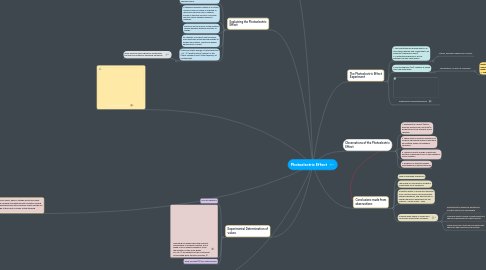Photoelectric Effect
by Cherry Nwe


1. In the experimental set-up for photoelectric effect, apply a voltage across the metal plates opposing electron movement and increase its magnitude until ammeter reading reaches 0. This is the point when even photoelectrons with maximum kinetic energy are unable to reach the collector. The voltage at this point is known as the stopping potential, Vₛ.
2. From W=qV, Kₘₐₓ =eVₛ
3. Maximum kinetic energy of photoelectrons determines the negative potential required to reduce the photoelectric current to zero, the stopping potential.
4. What is the Photoelectric Effect?
4.1. The emission of electrons when light shines on a material
5. Explaining the Photoelectric Effect
5.1. When light strikes the surface of a material, the photons are absorbed as energy by electrons on its surface. If there is enough energy, electrons are able to escape the material, resulting in emission of photoelectrons.
5.2. A threshold frequency exists as a certain minimum level of energy is required to remove an electron from a material, known as the work function. This work function varies between different materials.
5.3. Electrons on the surface of the material already possess different amounts of energy.
5.4. As intensity of incident light increases, more electrons absorb enough energy to escape the material, resulting in higher photoelectric current.
5.5. Maximum kinetic energy of a photoelectron = hf - Φ (work function), where h is the Planck constant, and f is the frequency of incident light.
5.5.1. Work function itself is given by multiplying the Planck constant by threshold frequency.
6. Experimental Determination of values
6.1. Kₘₐₓ of electrons
6.2. Repeating the experiment with different wavelengths of incident radiation, plot a graph of Kₘₐₓ against frequency. From the equation of this linear graph, eVₛ=hf-Φ, the negative of the y-intercept of this graph gives the work function, Φ.
6.3. Work function (Φ) of a metal surface
7. The Photoelectric Effect Experiment
7.1. 1. Two electrodes are placed apart in an evacuated chamber and connected to an ammeter (measures current) 2. A potential difference is set up between the two metal plates
7.1.1. Initially, ammeter measures no current.
7.2. 3. Electromagnetic (EM) radiation is shone onto one metal plate.
7.2.1. Immediately, a current is measured.
7.2.1.1. Electrons are emitted when EM radiation of sufficiently high frequency is incident on metal electrodes -> The Photoelectric Effect
7.3. Photoelectric Effect Experiment
8. Observations of the Photoelectric Effect
8.1. 1. Photoelectric current (rate of electron emission per unit time) is proportional to the intensity of EM radiation
8.2. 2. There exists a minimum frequency of incident light below which no electrons are emitted, known as threshold frequency
8.3. 3. Maximum kinetic energy of electrons emitted is dependent only on the frequency of EM radiation
8.4. 4. Emission of electrons begins instantaneously, without time lag
9. Conclusions made from observations
9.1. Light is quantized as photons
9.2. The energy of each photon of light is proportional to its frequency
9.3. A photon results in an electron emission from a metal surface if it has sufficient energy individually, and this amount of energy required is dependent on the material - usually metal - used.
9.4. Classical wave theory is invalid as it incorrectly predicts the following:
9.4.1. Photoelectrons should be emitted for incident light of any wavelength
9.4.2. Maximum kinetic energy of photoelectrons should be dependent on light intensity
9.4.3. There should be a time lag from when light shines to when electrons are emitted

